Summary
Currently, in the UK and much of Europe, slug pellets should not pose a threat to birds or mammals, including hedgehogs, although data are lacking at the time of writing. Prior to the spring of 2022, most pellets used in domestic gardens were metaldehyde-based, and we know that this chemical is toxic to most animals if ingested in high enough concentrations. In the case of the hedgehog, the LD50 of metaldehyde is believed to be about 500 mg/kg, suggesting it would take about 250 mg to kill a 500 gram (1 lb.) hedgehog -- about 1,000 pellets in a sitting. As unlikely as such consumption sounded at first, some veterinary pathology investigations had pointed to metaldehyde poisoning as the cause of death for hedgehogs, and wildlife rescues reported "drunk-like" behaviour in hogs suspected of having been poisoned by pellets. Furthermore, while the evidence to-date suggests the risk of poisoning from metaldehyde pellets was small, the pellets may reduce the hedgehog's prey base and have wider impacts in the ecosystem, so the UK government banned the production, sale, and use of pesticides containing this substance as of 1st April 2022. Domestic slug pellets will now typically contain ferric phosphate, chemically known as iron (III) phosphate, which is generally considered safe for vertebrate consumption, but there are concerns about the impact some of the chelating agents used to increase iron absorption may have on other invertebrate fauna, such as earthworms. Consequently, it remains the advice that pesticides should be used as a last resort and applied sparingly.
The details
Traditionally, slug pellets could generally be divided into three groups based on their main active ingredient: those containing methiocarb; those containing thiodicarb; and those containing metaldehyde (sometimes abbreviated to "meta"). The former two types were used almost exclusively in commercial agriculture, while metaldehyde pellets were, until recently, used on both a commercial and domestic basis. Following advice from the UK Expert Committee on Pesticides and the Health and Safety Executive about the possible risks that metaldehyde posed to birds and mammals, however, and following a failed attempt to implement at ban in 2018, it became illegal for manufacturers to supply metaldehyde products in the United Kingdom after the 31st March 2021, and the onward sale and use of the products was banned 12 months later, on 1st April 2022. Since then, the active ingredient in all domestic and many commercial slug pellets has been ferric phosphate, known chemically as iron (III) phosphate, which is considered to have a better environmental profile and to be less toxic to vertebrates. Before touching briefly on the current iron-based pesticides, we'll review some of the history, application, and issues with metaldehyde-based pesticides for slug control.
Mollusc malevolence
The potential for metaldehyde as a molluscicide, something that kills slugs and snails, was discovered by accident in the 1930s. In a paper to the Annals of Applied Biology during 1940, Ministry of Agriculture, Fisheries and Food biologist C. T. Grimingham wrote:
"A lady who was using 'meta-fuel' [metaldehyde in combustible tablet form] to heat her curling tongs and threw the remains out of the window afterwards observed an assemblage of dead slugs."

In 1937 Grimingham joined forces with H.C.F. Newton to write a short paper to the Journal of the Ministry of Agriculture in which they discussed the effectiveness of metaldehyde-containing slug baits. Based on their trials on swede and wheat plots, Grimingham and Newton found no evidence to suggest any soil invertebrates other than gastropods (i.e., slugs and snails) were affected by the poisoned baits. In other words, that metaldehyde had a highly specific toxicology. A more recent and more comprehensive study by Lise Samsoe-Petersen, Markus Bieri, and Wolfgang Buchs, published in Aspects of Applied Biology during 1992, supported the findings of Grimingham and Newton. Samsoe-Petersen and his colleagues tested the impact of methiocarb and metaldehyde on earthworms (Lumbricus terrestris), rove beetles (Aleochara bilineara), and four species of carabid beetles, concluding that:
"... metaldehyde showed no or negligible toxic effects, while methiocarb was toxic to beetles and deactivated the earthworms."
In this study, earthworm "deactivation" meant methiocarb caused them to stop feeding and caused them to retreat to their burrow.
Metaldehyde breaks down to form ethanal, also known as acetaldehyde, and this appears to primarily affect gastropod mucus cells. Within a few days the ethanal breaks down into acetic acid, and thereafter to carbon dioxide and water. For an excellent overview of metaldehyde and how it reacts with both the vertebrate metabolism and the environment, the reader is directed to Markus Bieri's article on The Environmental Profile of Metaldehyde (opens PDF in new window).
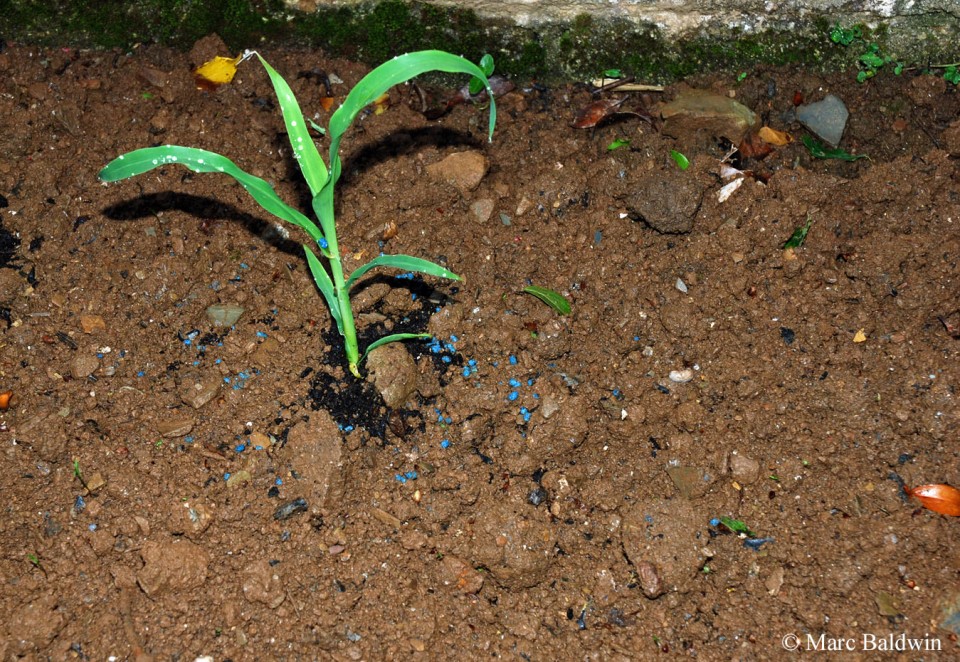
So, what is a slug pellet and what does it do to slugs? Currently, domestic slug pellets manufactured and sold in the UK are comprised of three main components: ferric phosphate (formerly metaldehyde) at a concentration of between 1% and 3%, which equates to a maximum concentration of about 30 mg per gram of pellets or roughly 0.3 mg per pellet in the smaller products; a cereal (bran) to attract the molluscs; and a blue dye. The blue dye is added in a bid to prevent birds from eating the pellets because laboratory studies have suggested birds seem less inclined to peck at blue objects. A study on house sparrows (Passer domesticus) by Iwona Pawlina and Gilbert Proulx, for example, found that giving seeds a blue coating greatly reduced the birds' tendency to eat them, while a similar study on red-winged blackbirds (Agelaius phoeniceus) by a team at the U.S. Department of Agriculture in Florida yielded similar results. The theory is that birds probably avoid eating blue objects because they're novel; there's nothing in their natural diet of a similar colour.
Much of our understanding of how the metaldehyde used in traditional slug pellets affected gastropods came from work by mollusc biologist Rita Triebskorn at the University of Tübingen in Germany. The precise mechanisms by which metaldehyde works are outside the scope of this article, but sufficed to say that Triebskorn and her colleagues discovered that it makes major changes to the structure of gastropod mucocytes, the cells that manufacture and secrete mucus, which cause them to produce excessive amounts mucus. In other words, they caused slugs and snails to fatally dehydrate themselves. This also explained why the these pellets were less effective in wet conditions, during which the gastropods could quickly rehydrate. Iron phosphate, by contrast, accumulates in the calcium spherules of the mollusc digestive glands, which interferes with the calcium metabolism in their gut, in turn disrupting feeding and mucus production. Some suppliers suggest that this causes the slugs and snails to retreat underground, but regardless the gastropods starve to death within three to six days.
Toxicity 101
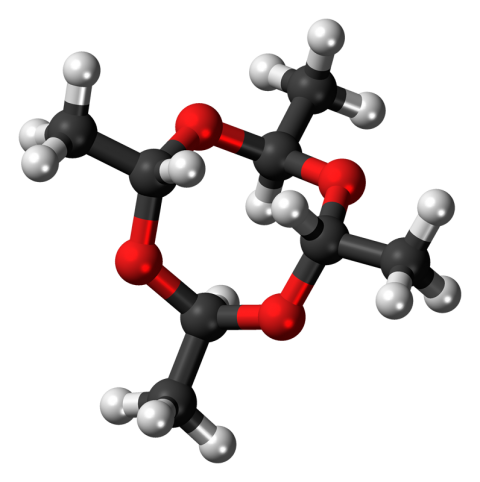
In order to consider the effects that slug pellets could have on hedgehogs, we must first consider how we measure toxicity (i.e., how poisonous a substance is) to animals. The most common methods of expressing toxicity are the Lethal Dose 50, or Lethal Concentration 50 for aquatic animals; often abbreviated to LD50 and LC50, respectively. Basically, these values tell you the concentration required to kill half (i.e., 50%) of the group of whatever species you're testing it on.
A number of problems are associated with LD and LC tests, not least that they give no indication of the underlying actions of the substances being tested. There are also various ethical concerns, which led to a change in the way the UK government issued licences for this testing, as well as more technical issues. Essentially, poisons can act in different ways when administered via different routes (e.g., if applied to the skin or swallowed). Likewise, toxicity can vary on an individual basis as well as across species, sometimes by a considerable degree. The susceptibility of an animal to a poison can depend on the other foods in its diet as well. Despite the problems and ethicality, it is the LD50 data for metaldehyde that is most abundant.
According to the World Health Authority, metaldehyde LD50 values range widely. In dogs, for example, the LD50 values can be anywhere from 100 to 1,000 mg/kg, depending on breed, while cats average 207 mg/kg, and rats fall in the range of 227 to 690 mg/kg. Human (generally children) deaths following metaldehyde ingestion have been recorded and, according to a 1958 paper in the journal Schweizerische Medizinische Wochenschrift (Swiss Medical Weekly), it has been used in at least two murders. In humans, symptoms of metaldehyde poisoning include stomach cramps, sickness, diarrhoea, fever, and convulsions -- ultimately, the symptoms can progress to coma and death. The Materials Safety Data Sheet for ferric phosphate supplied by Fisher Scientific gives the LD50 in rats as "above 2,000 mg/kg", so significantly higher than for metaldehyde, and the USDA Agricultural Marketing Service notes that the LD50 in humans is "greater than 5,000 mg/kg".

One prominent feature of metaldehyde poisoning in humans is the loss of memory. In a 1982 paper to the Western Journal of Medicine, medical doctors W.T. Longstreth Jr. and David Pierson reported on the case of a female school teacher who swallowed 470 mL of liquid slug bait in an apparent suicide attempt. The woman's recovery was hampered by "prolonged memory and psychomotor dysfunction" -- in other words, she had problems with her memory and coordinating her movements. In a personal communication to Nigel Reeve (mentioned in Hedgehogs), Les Stocker explained that meta-poisoned hedgehogs display increased hypersensitivity and excitability. In The Complete Hedgehog, Stocker elaborates, explaining that in his experience the "classic symptoms of metaldehyde poisoning" are extreme excitement and tremors, with some muscle stiffening and even partial paralysis. I know of no similar information regarding overconsumption of iron by hedgehogs. Clinical trials on humans suggest short-term excessive consumption of ferric phosphate results in an upset stomach and diarrhoea, vomiting, and depression, but that symptoms pass quickly. Overall, in their Fact Sheet on the compound, the Environmental Protection Agency in the USA state:
"Snails and slugs are more sensitive to the effects of iron phosphate than are other organisms. No toxicity was seen in mammals, birds, or fish. For several other organisms, including earthworms and certain ground beetles, no harmful effects are expected if users follow the application rates and use directions on the label."
Hogging slug pellets
A significant factor in the banning of metaldehyde and its replacement with ferric phosphate was not only the potential for hedgehogs and garden birds to be poisoned by eating the pellets, but also the potential for bioaccumulation - i.e., the predators eating a lot of poisoned slugs or snails. It had been generally assumed, however, that direct consumption of slug pellets by hedgehogs was unlikely, and if they were to consume slugs that had been killed by metaldehyde-based ones, they would need to eat unrealistic quantities to be affected themselves. Despite such assumptions, wildlife rescues were concerned, and there is actually some, albeit very limited, data on metaldehyde toxicity in hedgehogs. Pat Morris, in his The New Hedgehogs Book, told how, after writing to several slug pellet manufacturers, he was directed to the research of Professor Christian Schlatter in Switzerland, who seems to have been the first person to investigate the problem. According to Morris, Schlatter found that the LD50 of metaldehyde for hedgehogs was about 500 mg/kg, suggesting it would take about 250 mg to kill a 500g (1 lb.) hedgehog.
Based on the Schlatter's estimate, it was calculated that a hedgehog would need to eat somewhere in the region of 5,000 poisoned slugs before it reached the LD50 level. Similarly, working on the basis that smaller domestic slug pellets typically contained about 3% metaldehyde (i.e., 1 g of pellets contained 30 mg of meta), a hedgehog of 500 g would need to eat 8.3 g in one evening to accumulate 250 mg of the toxin. If we consider that the smaller domestic pellets weigh about 10 mg each, the hedgehog would need to eat 830 to reach this LD50 dose. Both scenarios seem highly unlikely, and it is not difficult to see why death as a direct result of metaldehyde poisoning was considered equally improbable. None of this, however, precluded hedgehogs from consuming some slug pellets and potentially suffering the effects.
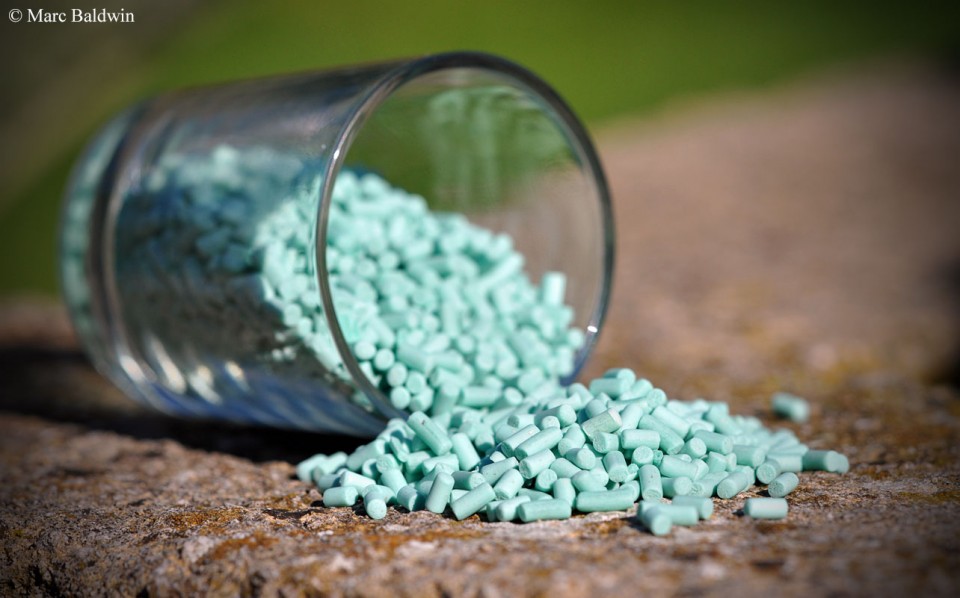
In a paper to The Veterinary Record during 1991 veterinarians Ian Keymer, E.A. Gibson, and Debby Reynolds presented their analysis of the causes of death for 74 hedgehogs recovered from 65 localities around East Anglia. Thirty-five carcasses were tested for metaldehyde and the vets found three individuals (8.6%) had probably died from metaldehyde poisoning. One individual had a meta concentration of 80 mg/kg in the liver, suggesting it had been absorbed into the bloodstream, while the other two were found to have 40 mg/kg of acetaldehyde (a meta breakdown product) in their stomachs. Four other hedgehogs yielded sub-lethal (i.e., less than 20 mg/kg) concentrations of metaldehyde in their stomach or kidneys. Referring to a discussion with Mark Fletcher at the Central Science Laboratory in York, Keymer and his colleagues wrote:
"Fletcher believes that hedgehogs are poisoned by eating metaldehyde based pellets rather than by eating slugs poisoned by the chemical."
Despite generally preferring to eat meat over plant material, Hubert Gemmeke found, during his studies at the German Federal Research Centre in Münster, that hedgehogs would eat slug pellets. Coincidentally, Gemmeke also noted that methiocarb pellets were apparently three-times more palatable than metaldehyde ones and, given this is significantly more toxic than meta, he calculated that a hedgehog could reach the LD50 in just two square metres (about 22 sq-ft).
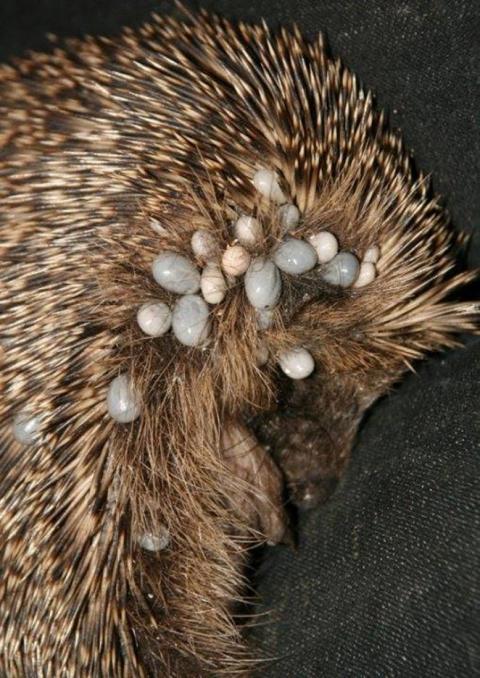
It had been suggested that hedgehogs might stand a greater chance of reaching the LD50 if they ate slug pellets and poisoned slugs while foraging. This seemed plausible, although some authors have noted how hedgehogs often treat moribund prey with suspicion, despite being known to feed on carrion. In addition, it may be argued that hedgehogs eating slug pellets in a laboratory doesn't necessarily mean they'll actively choose them while foraging naturally, or as an alternative to normal prey. Nonetheless, in the two decades or so preceding its banning, I knew of several wildlife rescues who reported receiving hedgehogs showing signs of metaldehyde poisoning each year and, in The Complete Hedgehog, Les Stocker wrote:
"All the same I believe that hedgehogs, especially youngsters, will pick up, lick and chew slug pellets especially as a stimulus to that peculiar hedgehog trait, self-lathering."
We have no data on the palatability of ferric phosphate pellets to hedgehogs. Iron in this form is sometimes used to fortify our foods and one might anticipate that anaemic hedgehogs could be attracted to them. We don't know how prevalent anaemia is in hedgehogs to be able to assess the probability of their attractiveness. Nonetheless, Miri Pfäffle and colleagues at the University of Karlsruhe in Germany published a paper in Parasitology during 2009 demonstrating how blood loss from tick infestations, which are an increasing problem among hedgehogs taken in by wildlife rescues in Britain, could be significant enough to cause anaemia and increased morbidity among the 36 hedgehogs in their study population. Of course, a source of iron in such circumstances may be a positive intervention, but iron in this form is not very bioavailable and data are lacking to know for sure.
Speculate to accumulate
While a hedgehog may not have eaten 830 metaldehyde-containing slug pellets in one sitting, or even over the course of one night, some authors suggested that toxic accumulation could've be a problem. When an animal or plant takes in certain chemicals, particularly fat-soluble ones, over time they can build-up within the tissues if the chemicals cannot be excreted or broken down as fast as they're taken in -- this process is called bioaccumulation. This can be the case even for iron, long-term excessive consumption of which can result in deposition in the liver where it can cause tissue damage.
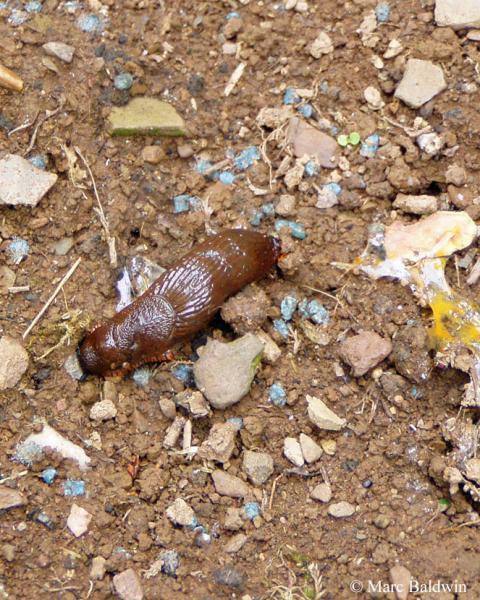
So, although a single hedgehog may never have come close to consuming, say, the 5,000 slugs required to get the full LD50 in one night, it might've eaten an average of 10 poisoned slugs per night over two years, which could lead to the accumulation of 7,300 slugs-worth of meta; more than enough to reach the LD50. Obviously, this is a very simple scenario that doesn't consider that hedgehogs, or slugs, may breakdown metaldehyde into harmless (or less harmful) components, or that hedgehogs may not absorb all the meta present in a dead slug; but it's an example of what we mean by bioaccumulation.
Despite concerns, there remains no evidence to suggest that metaldehyde bioaccumulates in the environment and, as Markus Bieri pointed out in his review, it's broken down into ethanal and, subsequently, water and carbon dioxide. Indeed, in terms of environmental persistence, it seems that methiocarb is more problematic and, in her fascinating review of the impacts of molluscicides on hedgehogs produced in collaboration with The Mammal Trust and Royal Holloway University, Jo Brunner wrote:
"Irrespective of the accuracy of the LD50 values, it remains that toxic residues [of methiocarb] are found in slugs and worms which can be passed on to the foraging hedgehog."
It had also been suggested that if hedgehogs are put off eating slugs by the mucus they produce, slugs poisoned with meta may be more attractive because they have reduced mucus secretion owing to being dehydrated. I know of no studies assessing this in hedgehogs, but an interesting series of experiments by Jacqueline Mair and Gordon Port at the University of Newcastle upon Tyne studied the effect of mucus production on the ability of two species of beetle to tackle slugs. Writing in the journal Biocontrol Science and Technology during 2002, they concluded:
"Results indicate that these generalist beetle species are unable to overcome the defence mucus production of healthy slugs. Slugs sub-lethally poisoned by molluscicides may be a more suitable prey item due to a reduction in defence mucus production."
We have no data on bioaccumulation of ferric phosphate in molluscs to know whether a hedgehog could reach the LD50 through a combination of pellet and slug consumption, but the iron doesn't impact mucus secretion in slugs or snails to the same extend as metaldehyde, which presumably doesn't alter their attractiveness or palatability to a passing hedgehog. Furthermore, contact with ferric phosphate may cause slugs to retreat underground, making them less likely to be found in the first place.
Fierce & subtle poison

While it is no longer legal to manufacture or purchase metaldehyde-containing slug bait in Britain, there are likely to be many containers leftover in sheds and garages and one anticipates that their application, particularly given that many farmers and gardeners have complained that ferric phosphate is a less effective pesticide, some application may continue "under the radar" of authorities for some time. Symptoms of metaldehyde poisoning in hedgehogs may also be easily overlooked, making it more difficult to identify its continued use. Some rescues report a wobbly, staggering or "drunk-like" movement in suspected cases of slug pellet poisoning, but this can also be caused by severe dehydration. In his wildlife veterinary bible, Practical Wildlife Care, the second edition of which was published in 2005, the late St. Tiggywinkles founder Les Stocker notes that metaldehyde poisoning often manifests as hyperaesthesia, where the hedgehog flinches at the slightest sound:
"Classic signs of metaldehyde poisoning include increased heart rate, anxiety, nystagmus, panting, salivating (probably not a sign in hedgehogs, which will salivate freely when they are self-lathering), stiff-legged gait, ataxia and vomiting. The author's experience with hedgehogs poisoned with metaldehyde is that they show severe hypersensitivity. The test is to click your fingers from the other side of the room. A poisoned hedgehog will flinch whereas a healthy one will not. It may also sometimes pass faeces the colour of the slug pellets."
Prior to it's recent ban, metaldehyde had been in widespread use for decades and concerns have also been raised that it may pose a longer-term threat to hedgehogs, impacting both their breeding biology and behaviour, although data are lacking. During the early 1990s, Hubert Gemmeke presented dead slugs, poisoned with slug pellets, to six hedgehogs and didn't observe any obvious physiological or behavioural effects in his subjects, even in those animals that ate nearly all of the 200 slugs offered. Subsequently, Uwe Plümer exposed 21 hedgehogs to varying concentrations of metaldehyde and monitored their behavioural response. His results, published in a German contribution to Mitteilungen aus der Biologischen Bundesanstalt during 2006, suggested that a dose of 70 mg/kg led to half the subjects showing a noticeable decrease of locomotor activity -- i.e., the hedgehogs moved around much less than those which weren't exposed -- and this might point to physiological issues and/or make them more susceptible to predators. Metaldehyde has also been shown to adversely affect reproduction and reduce pup survival rates in rats, but I can find no comparable data for hedgehogs.
Perhaps of greater significance are claims that mollusicides may have a more indirect impact on hedgehogs by reducing their potential prey base. We know, however, that metaldehyde is a highly specific toxin that decomposes readily to naturally occurring compounds and doesn't appear to pose a significant threat to most non-molluscan soil invertebrates. It therefore seems unlikely that other soil invertebrates would be badly hit by the application of domestic slug pellets. The same may not apply to iron-based products, however. Anthony Langan and Emma Shaw, in their 2006 paper to Applied Soil Ecology, for example, described how exposure to iron phosphate increased earthworm mortality. Futhermore, worms that survived exposure seemed to fair worse than the control group, gaining less weight than subjects exposed to metaldehyde and significantly less than the control group. Langan and Shaw also observed significant reductions in the rates at which pellets and leaves were removed from the soil surface after exposure to iron phosphate, indicating reduced surface foraging activity by the worms. Data from a handful of similar studies suggest that the chelating agent ethylenediaminetetraacetic acid (EDTA), which is used to bind the iron phosphate in slug baits to make it more available for absorption by molluscs, might adversely affect invertebrates such as earthworms and may also alter soil fungal communities.
Finally, do we have any idea how many hedgehogs might be killed by slug pellets each year? In short, no we don't. The Wildlife Incident Investigation Scheme (WIIS) was setup by DEFRA and is coordinated by the Central Science Laboratory's Wildlife Incident Unit in York with the aim of investigating "the deaths of wildlife, including beneficial insects and some pets, throughout the UK where there is evidence that pesticide poisoning may be involved." Hedgehogs appear very infrequently in the WIIS reports, and from all the reports available via their website (1998-2024), there are no records of hedgehogs having been poisoned with slug pellets. In fact, only two records of pesticide poisoning in a hedgehog appears: two animals were poisoned by bromadiolone (rat poison) in Norfolk during September 2004 after they apparently got access to an improperly secured trap, and one died of suspected bromadiolone poisoning in Strathclyde, Scotland, during May 2016. The relative scarcity of hedgehogs in these reports is perhaps not unexpected given these are small, solitary, secretive, nocturnal mammals that are easily overlooked.
In summary, we still cannot say for sure how much of a threat domestic metaldehyde-containing slug pellets represented (continue to represent?) to hedgehogs, but the evidence to-date suggests it's small. The ban on metaldehyde-based pesticides that came into force at the end of March 2022 was an attempt by the UK government to guard against what was seen as an "unacceptable risk" to birds and mammals and, on balance, it seems prudent to err on the side of caution and look for alternative approaches to garden pest control. Time will tell whether ferric phosphate is a more environmentally appropriate method of control and poses less risk to wildlife. It is perhaps interesting to note, however, that in 2009, law firm Steptoe LLP in Washington petitioned (albeit unsuccessfully) the USDA to remove ferric phosphate from the "National List" as a slug or snail bait. They argued that ferric phosphate alone wasn't as active or effective as molluscicides such as metaldehyde, something many gardeners and farmers in the UK have also raised as a concern, and it only had molluscicidal activity when formulated with a chelating agent, most of which seem to cause more significant issues for soil flora and fauna.